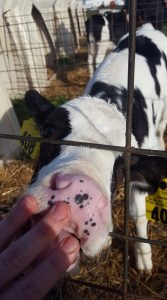During the field trip the farm superintendent of University of Delaware, Scott Hopkins, gave the class a tour of the agricultural field’s mechanical devices, identified the poultry houses and how they are used for research, demonstrated another form of research students focus on for dairy cows regarding a controlled ration being fed, explained the high tunnel and it’s purposes in operating as organic even though it is not verified organic, etc…Additionally when we rode the bus to Webb Farm, the research farm for UD students, Mr. Hopkins took us into the equine building and we briefly discussed how the mares could easily stop giving birth if there was the slightest disturbance during this time such as a student talking while waiting. I personally enjoyed the part of the tour where Scott picked up a handful of the ration being fed to the dairy cattle in controlled research classes because it smelled nice- I believe the ration was a cut up hay forage. Next we moved on to the sheep which I felt was the coolest part of the research farm because I’ve taken classes and learned about equine, poultry, beef and dairy cattle, but learned very little about sheep over my time at UD. During this part of the field trip, Mr. Hopkins talked about the male sheep having a device attached to his body that would spray paint on the back end of the females he would mount in order to check if the population was successfully impregnated. I found this interesting because he would change the color of the paint after a number of days which demonstrated if the first round of sperm was a hit or miss- if the first round impregnated the sheep, it would not have the new paint color demonstrating that the first attempt did not work.
Next we looked at the black Angus beef cattle in which Mr. Hopkins talked about the factors that come into consideration when he decides whether or not to cull a cow. For instance, if a cow decides it no longer wanted to mother a calf, he would remind this cow of it’s protective instinct to protect the cow, as a second chance before considering culling. Also, he briefly mentioned why the bulls were castrated before slaughter and why this was important for a consumer point of view. The reason being that a bull produces testosterone and when the bull is being slaughtered for it’s meat, the stress is shown in the meat because testosterone is produced which causes the color of the meat to turn into a dark blood red color, which is not favorable to consumers when they purchase the final product. I also learned that UDairy Creamery sells the meat that was raised on Webb farm, which is pretty cool because consumers of this generation care about factors such as how their food was raised by the farmer and what went into the process of making their product. Overall, this was a fun field trip and I learned a little more about how the animals are raised than I knew before.

